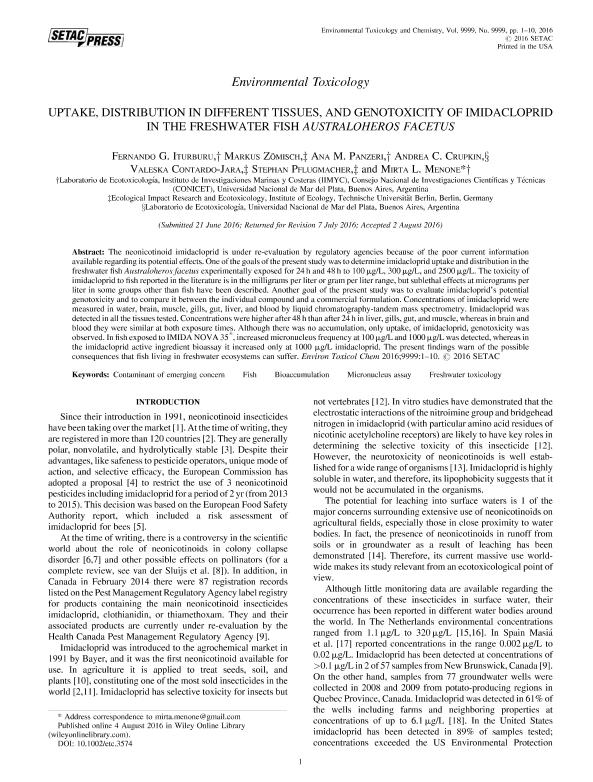Mostrar el registro sencillo del ítem
dc.contributor.author
Iturburu, Fernando Gastón

dc.contributor.author
Zömisch, Markus
dc.contributor.author
Panzeri, Ana María

dc.contributor.author
Crupkin, Andrea Carina

dc.contributor.author
Contardo Jara, Valeska
dc.contributor.author
Pflugmacher, Stephan
dc.contributor.author
Menone, Mirta Lujan

dc.date.available
2018-11-14T13:25:01Z
dc.date.issued
2017-03
dc.identifier.citation
Iturburu, Fernando Gastón; Zömisch, Markus; Panzeri, Ana María; Crupkin, Andrea Carina; Contardo Jara, Valeska; et al.; Uptake, distribution in different tissues, and genotoxicity of imidacloprid in the freshwater fish Australoheros facetus; Society of Environmental Toxicology and Chemistry; Environmental Toxicology and Chemistry; 36; 3; 3-2017; 699-708
dc.identifier.issn
0730-7268
dc.identifier.uri
http://hdl.handle.net/11336/64443
dc.description.abstract
The neonicotinoid imidacloprid is under re-evaluation by regulatory agencies because of the poor current information available regarding its potential effects. One of the goals of the present study was to determine imidacloprid uptake and distribution in the freshwater fish Australoheros facetus experimentally exposed for 24 h and 48 h to 100 μg/L, 300 μg/L, and 2500 μg/L. The toxicity of imidacloprid to fish reported in the literature is in the milligrams per liter or gram per liter range, but sublethal effects at micrograms per liter in some groups other than fish have been described. Another goal of the present study was to evaluate imidacloprid's potential genotoxicity and to compare it between the individual compound and a commercial formulation. Concentrations of imidacloprid were measured in water, brain, muscle, gills, gut, liver, and blood by liquid chromatography-tandem mass spectrometry. Imidacloprid was detected in all the tissues tested. Concentrations were higher after 48 h than after 24 h in liver, gills, gut, and muscle, whereas in brain and blood they were similar at both exposure times. Although there was no accumulation, only uptake, of imidacloprid, genotoxicity was observed. In fish exposed to IMIDA NOVA 35®, increased micronucleus frequency at 100 µg/L and 1000 µg/L was detected, whereas in the imidacloprid active ingredient bioassay it increased only at 1000 µg/L imidacloprid. The present findings warn of the possible consequences that fish living in freshwater ecosystems can suffer. Environ Toxicol Chem 2017;36:699–708. © 2016 SETAC.
dc.format
application/pdf
dc.language.iso
eng
dc.publisher
Society of Environmental Toxicology and Chemistry

dc.rights
info:eu-repo/semantics/openAccess
dc.rights.uri
https://creativecommons.org/licenses/by-nc-sa/2.5/ar/
dc.subject
Bioaccumulation
dc.subject
Contaminant of Emerging Concern
dc.subject
Fish
dc.subject
Freshwater Toxicology
dc.subject
Micronucleus Assay
dc.subject.classification
Meteorología y Ciencias Atmosféricas

dc.subject.classification
Ciencias de la Tierra y relacionadas con el Medio Ambiente

dc.subject.classification
CIENCIAS NATURALES Y EXACTAS

dc.title
Uptake, distribution in different tissues, and genotoxicity of imidacloprid in the freshwater fish Australoheros facetus
dc.type
info:eu-repo/semantics/article
dc.type
info:ar-repo/semantics/artículo
dc.type
info:eu-repo/semantics/publishedVersion
dc.date.updated
2018-10-23T14:48:26Z
dc.identifier.eissn
1552-8618
dc.journal.volume
36
dc.journal.number
3
dc.journal.pagination
699-708
dc.journal.pais
Estados Unidos

dc.journal.ciudad
Nueva York
dc.description.fil
Fil: Iturburu, Fernando Gastón. Consejo Nacional de Investigaciones Científicas y Técnicas. Centro Científico Tecnológico Conicet - Mar del Plata. Instituto de Investigaciones Marinas y Costeras. Universidad Nacional de Mar del Plata. Facultad de Ciencias Exactas y Naturales. Instituto de Investigaciones Marinas y Costeras; Argentina
dc.description.fil
Fil: Zömisch, Markus. Technishe Universitat Berlin; Alemania
dc.description.fil
Fil: Panzeri, Ana María. Consejo Nacional de Investigaciones Científicas y Técnicas. Centro Científico Tecnológico Conicet - Mar del Plata. Instituto de Investigaciones Marinas y Costeras. Universidad Nacional de Mar del Plata. Facultad de Ciencias Exactas y Naturales. Instituto de Investigaciones Marinas y Costeras; Argentina
dc.description.fil
Fil: Crupkin, Andrea Carina. Universidad Nacional de Mar del Plata. Facultad de Ciencias Exactas y Naturales. Departamento de Ciencias Marinas. Laboratorio de Ecotoxicología; Argentina
dc.description.fil
Fil: Contardo Jara, Valeska. Technishe Universitat Berlin; Alemania
dc.description.fil
Fil: Pflugmacher, Stephan. Technishe Universitat Berlin; Alemania
dc.description.fil
Fil: Menone, Mirta Lujan. Consejo Nacional de Investigaciones Científicas y Técnicas. Centro Científico Tecnológico Conicet - Mar del Plata. Instituto de Investigaciones Marinas y Costeras. Universidad Nacional de Mar del Plata. Facultad de Ciencias Exactas y Naturales. Instituto de Investigaciones Marinas y Costeras; Argentina
dc.journal.title
Environmental Toxicology and Chemistry

dc.relation.alternativeid
info:eu-repo/semantics/altIdentifier/doi/https://dx.doi.org/10.1002/etc.3574
dc.relation.alternativeid
info:eu-repo/semantics/altIdentifier/url/https://setac.onlinelibrary.wiley.com/doi/abs/10.1002/etc.3574
Archivos asociados
